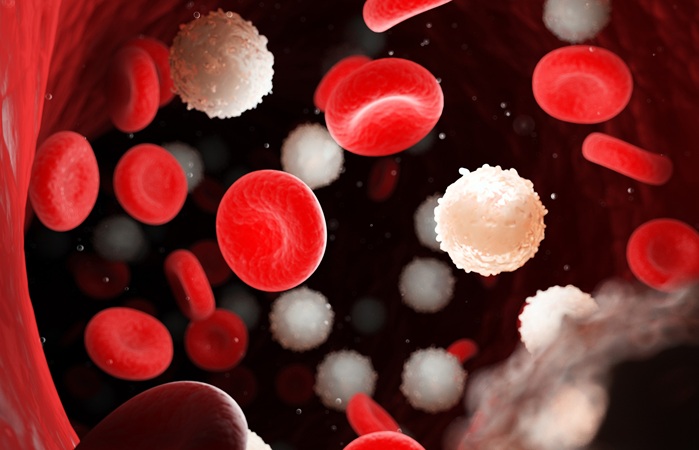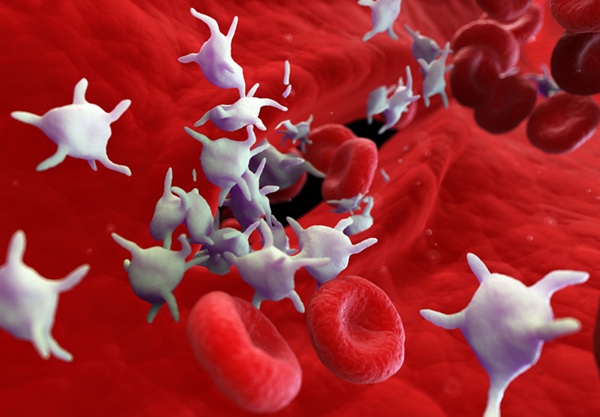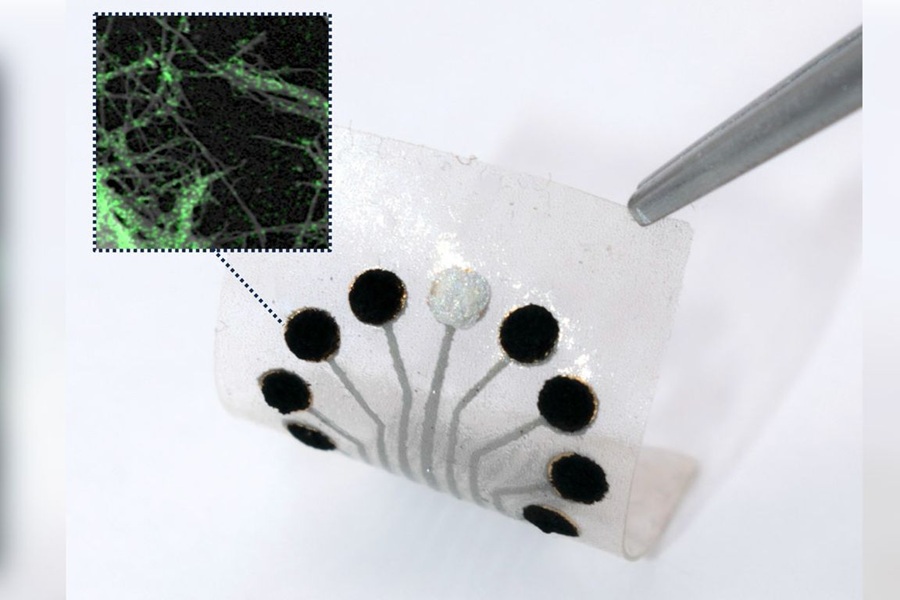Rapid Test Uses Glow-in-the-Dark Paper
|
By LabMedica International staff writers Posted on 16 Oct 2018 |
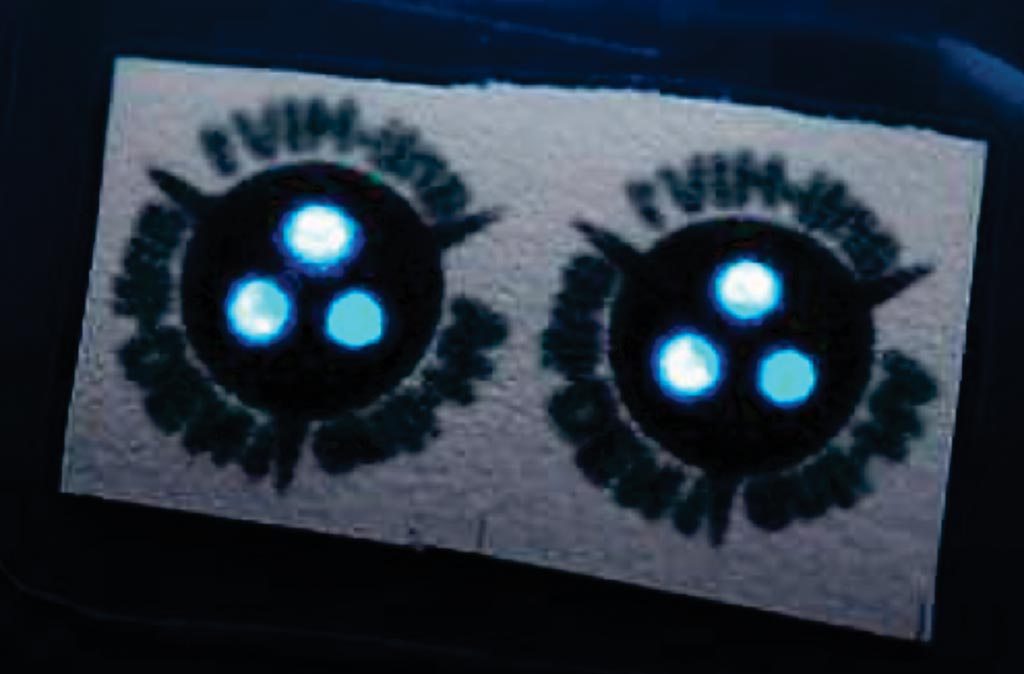
Image: This close-up of the glow-in-the-dark paper strip contains two copies of the test. The three glowing dots per test indicate that you can check on three different antibodies within one test (Photo courtesy of Bart van Overbeeke).
A practicable and reliable way to test for infectious diseases has been found and all that is needed are a special glowing paper strip, a drop of blood and a digital camera.
The test uses fully integrated “sample‐in‐signal‐out” microfluidic paper‐based analytical devices (μPADs) relying on bioluminescence resonance energy transfer (BRET) switches for analyte recognition and colorimetric signal generation.
Scientists from the Eindhoven University of Technology (Eindhoven, the Netherlands) and their colleagues at the Keio University (Kohoku-ku, Japan) developed the devices use BRET‐based antibody sensing proteins integrated into vertically assembled layers of functionalized paper, and their design enables sample volume‐independent and fully reagent‐free operation, including on‐device blood plasma separation. User operation is limited to the application of a single drop (20–30 μL) of sample (serum, whole blood) and the acquisition of a photograph 20 minutes after sample introduction, with no requirement for precise pipetting, liquid handling, or analytical equipment except for a camera.
The color is created thanks to the secret ingredient of the paper strip: a so-called luminous sensor protein. After a droplet of blood comes onto the paper, this protein triggers a reaction in which blue light is produced (known as bioluminescence). An enzyme that also illuminates fireflies and certain fish, for example, plays a role in this. In a second step, the blue light is converted into green light, but here comes the clue: if an antibody binds to the sensor protein, it blocks the second step. A lot of green means few antibodies and, vice versa, less green means more antibodies.
The ratio of blue and green light can be used to derive the concentration of antibodies. By measuring the ratio precisely, they suffer less from problems that other biosensors often have, such as the signal becoming weaker over time. In their prototype, the team successfully tested three antibodies simultaneously, for human immunodeficiency virus (HIV), influenza and dengue fever. Maarten Merkx, PhD, a professor of Bioengineering and a leading author of the study, said, “A biochemical reaction causes the underside of paper to emit blue-green light; the bluer the color, the higher the concentration of antibodies. A digital camera, for example from a mobile phone, is sufficient to determine the exact color and thus the result.” The study was published on August 31, 2018, in the journal Angewandte Chemie International Edition.
Related Links:
Eindhoven University of Technology
Keio University
The test uses fully integrated “sample‐in‐signal‐out” microfluidic paper‐based analytical devices (μPADs) relying on bioluminescence resonance energy transfer (BRET) switches for analyte recognition and colorimetric signal generation.
Scientists from the Eindhoven University of Technology (Eindhoven, the Netherlands) and their colleagues at the Keio University (Kohoku-ku, Japan) developed the devices use BRET‐based antibody sensing proteins integrated into vertically assembled layers of functionalized paper, and their design enables sample volume‐independent and fully reagent‐free operation, including on‐device blood plasma separation. User operation is limited to the application of a single drop (20–30 μL) of sample (serum, whole blood) and the acquisition of a photograph 20 minutes after sample introduction, with no requirement for precise pipetting, liquid handling, or analytical equipment except for a camera.
The color is created thanks to the secret ingredient of the paper strip: a so-called luminous sensor protein. After a droplet of blood comes onto the paper, this protein triggers a reaction in which blue light is produced (known as bioluminescence). An enzyme that also illuminates fireflies and certain fish, for example, plays a role in this. In a second step, the blue light is converted into green light, but here comes the clue: if an antibody binds to the sensor protein, it blocks the second step. A lot of green means few antibodies and, vice versa, less green means more antibodies.
The ratio of blue and green light can be used to derive the concentration of antibodies. By measuring the ratio precisely, they suffer less from problems that other biosensors often have, such as the signal becoming weaker over time. In their prototype, the team successfully tested three antibodies simultaneously, for human immunodeficiency virus (HIV), influenza and dengue fever. Maarten Merkx, PhD, a professor of Bioengineering and a leading author of the study, said, “A biochemical reaction causes the underside of paper to emit blue-green light; the bluer the color, the higher the concentration of antibodies. A digital camera, for example from a mobile phone, is sufficient to determine the exact color and thus the result.” The study was published on August 31, 2018, in the journal Angewandte Chemie International Edition.
Related Links:
Eindhoven University of Technology
Keio University
Latest Microbiology News
- Handheld Device Delivers Low-Cost TB Results in Less Than One Hour
- New AI-Based Method Improves Diagnosis of Drug-Resistant Infections
- Breakthrough Diagnostic Technology Identifies Bacterial Infections with Almost 100% Accuracy within Three Hours
- Innovative ID/AST System to Help Diagnose Infectious Diseases and Combat AMR
- Gastrointestinal Panel Delivers Rapid Detection of Five Common Bacterial Pathogens for Outpatient Use
- Rapid PCR Testing in ICU Improves Antibiotic Stewardship
- Unique Genetic Signature Predicts Drug Resistance in Bacteria
- Unique Barcoding System Tracks Pneumonia-Causing Bacteria as They Infect Blood Stream
- Rapid Sepsis Diagnostic Test Demonstrates Improved Patient Care and Cost Savings in Hospital Application
- Rapid Diagnostic System to Detect Neonatal Sepsis Within Hours
- Novel Test to Diagnose Bacterial Pneumonia Directly from Whole Blood
- Interferon-γ Release Assay Effective in Patients with COPD Complicated with Pulmonary Tuberculosis
- New Point of Care Tests to Help Reduce Overuse of Antibiotics
- 30-Minute Sepsis Test Differentiates Bacterial Infections, Viral Infections, and Noninfectious Disease
- CRISPR-TB Blood Test to Enable Early Disease Diagnosis and Public Screening
- Syndromic Panel Provides Fast Answers for Outpatient Diagnosis of Gastrointestinal Conditions
Channels
Clinical Chemistry
view channel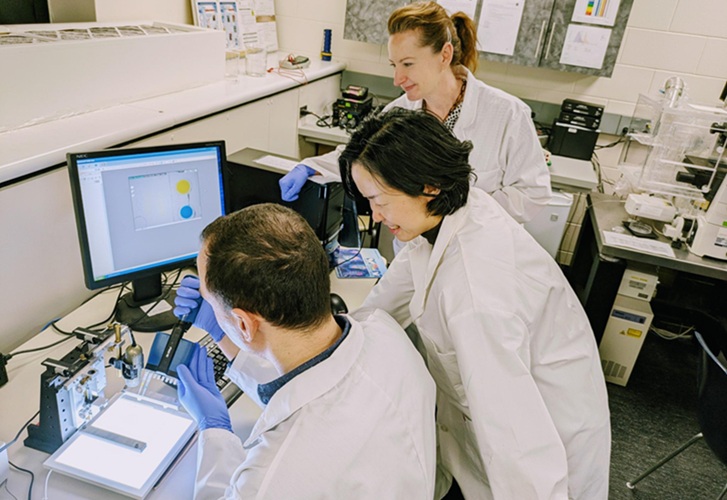
Low-Cost Portable Screening Test to Transform Kidney Disease Detection
Millions of individuals suffer from kidney disease, which often remains undiagnosed until it has reached a critical stage. This silent epidemic not only diminishes the quality of life for those affected... Read more
New Method Uses Pulsed Infrared Light to Find Cancer's 'Fingerprints' In Blood Plasma
Cancer diagnoses have traditionally relied on invasive or time-consuming procedures like tissue biopsies. Now, new research published in ACS Central Science introduces a method that utilizes pulsed infrared... Read moreMolecular Diagnostics
view channel
Novel Autoantibody Against DAGLA Discovered in Cerebellitis
Autoimmune cerebellar ataxias are strongly disabling disorders characterized by an impaired ability to coordinate muscle movement. Cerebellar autoantibodies serve as useful biomarkers to support rapid... Read more
Gene-Based Blood Test Accurately Predicts Tumor Recurrence of Advanced Skin Cancer
Melanoma, an aggressive form of skin cancer, becomes extremely difficult to treat once it spreads to other parts of the body. For patients with metastatic melanoma tumors that cannot be surgically removed... Read moreHematology
view channel
New Scoring System Predicts Risk of Developing Cancer from Common Blood Disorder
Clonal cytopenia of undetermined significance (CCUS) is a blood disorder commonly found in older adults, characterized by mutations in blood cells and a low blood count, but without any obvious cause or... Read more
Non-Invasive Prenatal Test for Fetal RhD Status Demonstrates 100% Accuracy
In the United States, approximately 15% of pregnant individuals are RhD-negative. However, in about 40% of these cases, the fetus is also RhD-negative, making the administration of RhoGAM unnecessary.... Read moreImmunology
view channel
Stem Cell Test Predicts Treatment Outcome for Patients with Platinum-Resistant Ovarian Cancer
Epithelial ovarian cancer frequently responds to chemotherapy initially, but eventually, the tumor develops resistance to the therapy, leading to regrowth. This resistance is partially due to the activation... Read more
Machine Learning-Enabled Blood Test Predicts Immunotherapy Response in Lymphoma Patients
Chimeric antigen receptor (CAR) T-cell therapy has emerged as one of the most promising recent developments in the treatment of blood cancers. However, over half of non-Hodgkin lymphoma (NHL) patients... Read morePathology
view channel
Novel UV and Machine Learning-Aided Method Detects Microbial Contamination in Cell Cultures
Cell therapy holds great potential in treating diseases such as cancers, inflammatory conditions, and chronic degenerative disorders by manipulating or replacing cells to restore function or combat disease.... Read more
New Error-Corrected Method to Help Detect Cancer from Blood Samples Alone
"Liquid biopsy" technology, which relies on blood tests for early cancer detection and monitoring cancer burden in patients, has the potential to transform cancer care. However, detecting the mutational... Read more
"Metal Detector" Algorithm Hunts Down Vulnerable Tumors
Scientists have developed an algorithm capable of functioning as a "metal detector" to identify vulnerable tumors, marking a significant advancement in personalized cancer treatment. This breakthrough... Read more
Novel Technique Uses ‘Sugar’ Signatures to Identify and Classify Pancreatic Cancer Cell Subtypes
Pancreatic cancer is often asymptomatic in its early stages, making it difficult to detect until it has progressed. Consequently, only 15% of pancreatic cancers are diagnosed early enough to allow for... Read moreTechnology
view channel
Pain-On-A-Chip Microfluidic Device Determines Types of Chronic Pain from Blood Samples
Chronic pain is a widespread condition that remains difficult to manage, and existing clinical methods for its treatment rely largely on self-reporting, which can be subjective and especially problematic... Read more
Innovative, Label-Free Ratiometric Fluorosensor Enables More Sensitive Viral RNA Detection
Viruses present a major global health risk, as demonstrated by recent pandemics, making early detection and identification essential for preventing new outbreaks. While traditional detection methods are... Read moreIndustry
view channel
Cepheid and Oxford Nanopore Technologies Partner on Advancing Automated Sequencing-Based Solutions
Cepheid (Sunnyvale, CA, USA), a leading molecular diagnostics company, and Oxford Nanopore Technologies (Oxford, UK), the company behind a new generation of sequencing-based molecular analysis technologies,... Read more
Grifols and Tecan’s IBL Collaborate on Advanced Biomarker Panels
Grifols (Barcelona, Spain), one of the world’s leading producers of plasma-derived medicines and innovative diagnostic solutions, is expanding its offer in clinical diagnostics through a strategic partnership... Read more















